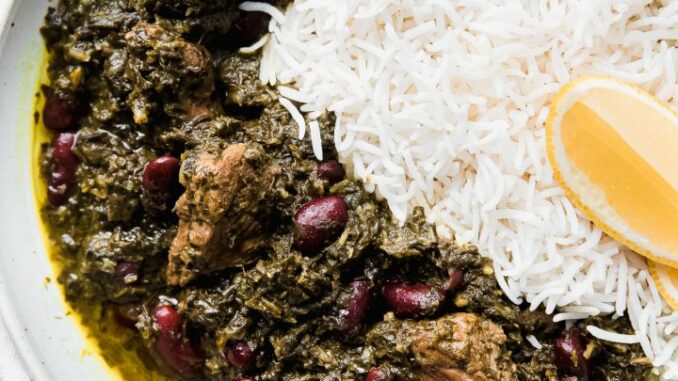
Ghormeh Sabzi, often hailed as the national dish of Iran, is a flavorful and aromatic stew that holds a special place in Iranian cuisine. This beloved dish is renowned for its rich blend of herbs, tender meat, and tangy flavor profile, making it a favorite choice for gatherings, celebrations, and everyday meals. In this extensive guide, we’ll delve into the origins of Ghormeh Sabzi, explore its cultural significance, and provide a detailed recipe to recreate this iconic Iranian dish at home.
History and Cultural Significance
Ghormeh Sabzi has ancient roots in Persian culinary tradition, with recipes passed down through generations over centuries. The name “Ghormeh Sabzi” translates to “fried herbs” in Persian, highlighting the dish’s key ingredient: a vibrant medley of fresh herbs. While the exact origins of Ghormeh Sabzi are difficult to pinpoint, it is believed to have originated in the region of Khorasan in northeastern Iran, where herbs are abundant and widely used in cooking.
As with many traditional dishes, Ghormeh Sabzi reflects the culinary heritage and cultural diversity of Iran. It is a testament to the country’s rich agricultural landscape and the ingenuity of its people in creating delicious and nutritious meals from locally available ingredients. Over time, Ghormeh Sabzi has become an integral part of Iranian cuisine, enjoyed by people of all backgrounds and generations.
Beyond its culinary appeal, Ghormeh Sabzi holds deep cultural significance for Iranians, often serving as a symbol of hospitality, warmth, and shared traditions. It is a dish commonly prepared for special occasions such as Nowruz (Persian New Year), weddings, and family gatherings, where it is served with pride and shared with loved ones.
Recipe for Ghormeh Sabzi
Now, let’s explore a traditional recipe for Ghormeh Sabzi, featuring tender meat, fragrant herbs, and tangy flavors:
Ingredients:
- 1 lb (450g) stewing beef or lamb, cut into cubes
- 2 cups chopped fresh herbs (parsley, cilantro, and scallions)
- 1 cup chopped spinach
- 1 onion, finely chopped
- 4 cloves garlic, minced
- 1 tablespoon dried fenugreek leaves (optional)
- 1 teaspoon ground turmeric
- 1 teaspoon ground cumin
- 1/2 teaspoon ground cinnamon
- 1/4 teaspoon ground black pepper
- 2 tablespoons vegetable oil
- 2 cups beef or vegetable broth
- 1 can (15 oz) red kidney beans, drained and rinsed
- Juice of 1-2 limes or lemons
- Salt to taste
Instructions:
- Heat the vegetable oil in a large pot over medium heat. Add the chopped onions and sauté until golden brown, about 5-7 minutes.
- Add the minced garlic, ground turmeric, ground cumin, ground cinnamon, and ground black pepper to the pot. Stir well to combine and cook for another 2-3 minutes until fragrant.
- Add the cubed beef or lamb to the pot and brown on all sides, about 5-7 minutes.
- Once the meat is browned, add the chopped fresh herbs (parsley, cilantro, and scallions), chopped spinach, and dried fenugreek leaves (if using) to the pot. Stir well to combine.
- Pour in the beef or vegetable broth and bring the mixture to a simmer. Cover the pot and let it cook over low heat for 1-2 hours, or until the meat is tender and the flavors have melded together.
- Once the meat is tender, add the drained and rinsed red kidney beans to the pot. Stir well and let it simmer for an additional 15-20 minutes.
- Just before serving, squeeze the juice of 1-2 limes or lemons into the pot to add a tangy flavor to the stew. Season with salt to taste.
- Serve the Ghormeh Sabzi hot, accompanied by steamed basmati rice or Persian saffron rice.
Tips for Perfect Ghormeh Sabzi:
- Use a combination of fresh herbs, including parsley, cilantro, and scallions, to achieve the authentic flavor of Ghormeh Sabzi.
- If you’re unable to find fresh fenugreek leaves, you can use dried fenugreek leaves (also known as kasuri methi) instead. However, fresh fenugreek leaves are preferred for their vibrant flavor.
- Adjust the amount of lime or lemon juice according to your taste preferences. The citrus adds a refreshing and tangy element to the stew.
- Ghormeh Sabzi is traditionally served with steamed basmati rice or Persian saffron rice, but you can also enjoy it with flatbread or lavash.
Conclusion
Ghormeh Sabzi is more than just a dish; it’s a culinary masterpiece that embodies the rich flavors, heritage, and hospitality of Iranian culture. From its humble origins in the kitchens of ancient Persia to its status as a beloved national dish, Ghormeh Sabzi has stood the test of time and continues to delight food enthusiasts around the world with its aromatic herbs, tender meat, and tangy flavors. Whether enjoyed at a festive gathering or a cozy family dinner, Ghormeh Sabzi brings people together to savor the vibrant tastes and shared traditions of Iranian cuisine.